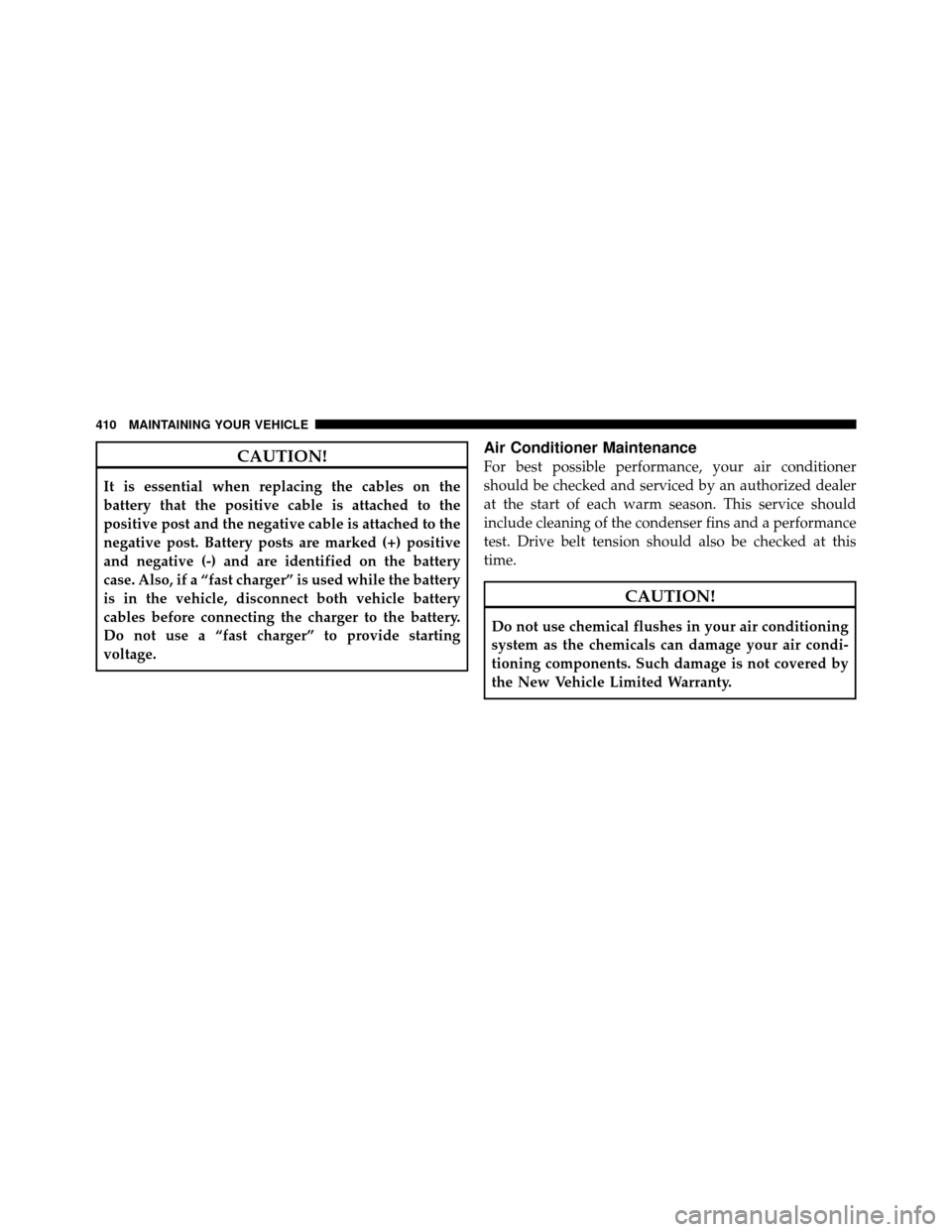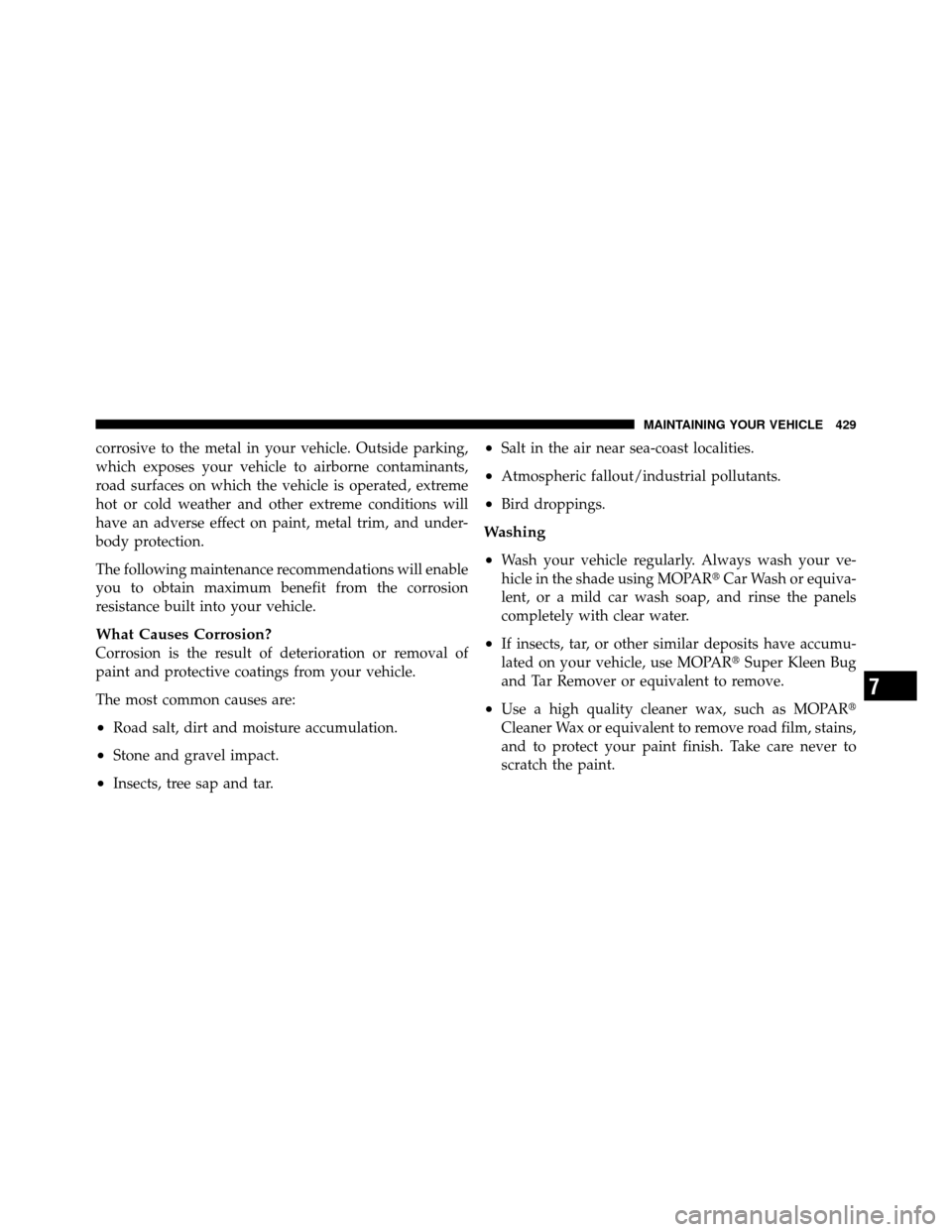Page 412 of 502

CAUTION!
It is essential when replacing the cables on the
battery that the positive cable is attached to the
positive post and the negative cable is attached to the
negative post. Battery posts are marked (+) positive
and negative (-) and are identified on the battery
case. Also, if a “fast charger” is used while the battery
is in the vehicle, disconnect both vehicle battery
cables before connecting the charger to the battery.
Do not use a “fast charger” to provide starting
voltage.
Air Conditioner Maintenance
For best possible performance, your air conditioner
should be checked and serviced by an authorized dealer
at the start of each warm season. This service should
include cleaning of the condenser fins and a performance
test. Drive belt tension should also be checked at this
time.
CAUTION!
Do not use chemical flushes in your air conditioning
system as the chemicals can damage your air condi-
tioning components. Such damage is not covered by
the New Vehicle Limited Warranty.
410 MAINTAINING YOUR VEHICLE
Page 413 of 502

WARNING!
•Use only refrigerants and compressor lubricants
approved by the manufacturer for your air condi-
tioning system. Some unapproved refrigerants are
flammable and can explode, injuring you. Other
unapproved refrigerants or lubricants can cause
the system to fail, requiring costly repairs. Refer to
Section 3 of the Warranty Information Book for
further warranty information.
•The air conditioning system contains refrigerant
under high pressure. To avoid risk of personal
injury or damage to the system, adding refrigerant
or any repair requiring lines to be disconnected
should be done by an experienced repairman.
NOTE: Use only manufacturer approved A/C System
Sealers, Stop Leak Products, Seal Conditioners, Compres-
sor Oil, and Refrigerants.
Refrigerant Recovery and Recycling
R-134a Air Conditioning Refrigerant is a hydrofluoro-
carbon (HFC) that is endorsed by the Environmental
Protection Agency (EPA) and is an ozone-saving product.
However, the manufacturer recommends that air condi-
tioning service be performed by authorized dealers or
other service facilities using recovery and recycling
equipment.
Body Lubrication
Locks and all body pivot points, including such items as
seat tracks, door hinge pivot points and rollers, liftgate,
tailgate, sliding doors and hood hinges, should be lubri-
cated periodically with a lithium-based grease, such as
MOPAR� Spray White Lube or equivalent, to assure
quiet, easy operation and to protect against rust and
wear. Prior to the application of any lubricant, the parts
concerned should be wiped clean to remove dust and
grit; after lubricating, excess oil and grease should be
removed. Particular attention should also be given to
7
MAINTAINING YOUR VEHICLE 411
Page 423 of 502

engine coolant (antifreeze) needs to be added, the
contents of the coolant recovery bottle must also be
protected against freezing.
•If frequent engine coolant (antifreeze) additions are
required, or if the level in the recovery bottle does not
drop when the engine cools, the cooling system should
be pressure-tested for leaks.
•Maintain the engine coolant (antifreeze) concentration
at 50% HOAT engine coolant (antifreeze) (minimum)
and distilled water for proper corrosion protection of
your engine which contains aluminum components.
•Make sure that the radiator and coolant recovery
bottle hoses are not kinked or obstructed.
•Keep the front of the radiator clean. If your vehicle is
equipped with air conditioning, keep the front of the
condenser clean.
•Do not change the thermostat for Summer or Winter
operation. If replacement is ever necessary, install
ONLY the correct type thermostat. Other designs may
result in unsatisfactory cooling performance, poor gas
mileage, and increased emissions.
Brake System
In order to assure brake system performance, all brake
system components should be inspected periodically.
Refer to the “Maintenance Schedule” in Section 8 for the
proper maintenance intervals.
WARNING!
Riding the brakes can lead to brake failure and
possibly an accident. Driving with your foot resting
or riding on the brake pedal can result in abnormally
high brake temperatures, excessive lining wear, and
possible brake damage. You would not have your full
braking capacity in an emergency.7
MAINTAINING YOUR VEHICLE 421
Page 430 of 502

Selection of Lubricant
Use only manufacturer’s recommended fluid. Refer to
“Fluids, Lubricants, and Genuine Parts” in this section
for the correct fluid type.
Maintenance After Off-Road Driving
After extended operation in mud, sand or water, or
similar dirty conditions, have your brake drums, brake
linings, and axle joints inspected and cleaned as soon as
possible. This will prevent any abrasive material from
causing excessive wear or unpredictable braking action.
Following off-road usage, completely inspect the under-
body of your vehicle. Check the tires, body structure,
steering, suspension and exhaust system for damage.
Check the threaded fasteners for looseness, particularly
on the chassis, drivetrain components, steering and sus-
pension. Retighten, if required, to torque values specified
in the Service Manual. Also check for accumulations of
vegetation or brush that could become a fire hazard, orconceal damage to fuel lines, brake hoses, axle pinion
seals, and propeller shafts. Check the air conditioning
drain tube on the lower dash wall in the engine compart-
ment for mud or debris, and clean as required. A plugged
tube will adversely affect air conditioning performance.CAUTION!
Under frequent heavy-duty driving conditions,
change all lubricants, and lubricate body compo-
nents more often than in normal service to prevent
excessive wear.
Appearance Care and Protection from Corrosion
Protection of Body and Paint from Corrosion
Vehicle body care requirements vary according to geo-
graphic locations and usage. Chemicals that make roads
passable in snow and ice, and those that are sprayed on
trees and road surfaces during other seasons, are highly
428 MAINTAINING YOUR VEHICLE
Page 431 of 502

corrosive to the metal in your vehicle. Outside parking,
which exposes your vehicle to airborne contaminants,
road surfaces on which the vehicle is operated, extreme
hot or cold weather and other extreme conditions will
have an adverse effect on paint, metal trim, and under-
body protection.
The following maintenance recommendations will enable
you to obtain maximum benefit from the corrosion
resistance built into your vehicle.
What Causes Corrosion?
Corrosion is the result of deterioration or removal of
paint and protective coatings from your vehicle.
The most common causes are:
•Road salt, dirt and moisture accumulation.
•Stone and gravel impact.
•Insects, tree sap and tar.
•Salt in the air near sea-coast localities.
•Atmospheric fallout/industrial pollutants.
•Bird droppings.
Washing
•
Wash your vehicle regularly. Always wash your ve-
hicle in the shade using MOPAR�Car Wash or equiva-
lent, or a mild car wash soap, and rinse the panels
completely with clear water.
•If insects, tar, or other similar deposits have accumu-
lated on your vehicle, use MOPAR� Super Kleen Bug
and Tar Remover or equivalent to remove.
•Use a high quality cleaner wax, such as MOPAR�
Cleaner Wax or equivalent to remove road film, stains,
and to protect your paint finish. Take care never to
scratch the paint.
7
MAINTAINING YOUR VEHICLE 429
Page 441 of 502
Cavity CartridgeFuseMini
Fuse Description
M11 10 Amp
Red (Ignition Off Draw)
IOD-HVAC/ATC,
MW SENSR, Under-
hood Lamp (UH
LMP)
M12 30 Amp
Green Amplifier (AMP)
M13 20 Amp
Yellow Ignition Off Draw—
Cabin Compartment
Node (IOD-CCN),
Wireless Control
Module (WCM), SI-
REN, Multifunction
Control Switch (MUL-
TIFCTN SW)
M14 20 Amp
Yellow Trailer Tow (Export
Only)Cavity Cartridge
FuseMini
Fuse Description
M15 20 Amp YellowCOL MOD, IR SNS,
Heater Ventilation,
Air Conditioning/
Automatic Tempera-
ture Control (HVAC/
ATC), Rear View
Mirror (RR VW MIR),
Cabin Compartment
Node (CCN), Transfer
Case Switch (T-CASE
SW), RUN/ST, Multi-
Function Control
Switch (MULTIFTCN
SW), Tire Pressure
Monitor (TPM), Glow
Plug Module (GLW
PLG MOD) — Export
Diesel Only
7
MAINTAINING YOUR VEHICLE 439
Page 443 of 502
Cavity CartridgeFuseMini
Fuse Description
M30 15 Amp
Blue Wiper Motor Frt,
J1962 Diagnostic Feed
M31 20 Amp
Yellow Backup Lamps (B/U
LAMPS)
M32 10 Amp
Red Occupant Restraint
Controller (ORC), TT
EUROPE
M33 10 Amp
Red Next Generation Con-
troller (NGC), Global
Powertrain Engine
Controller (GPEC)Cavity Cartridge
FuseMini
Fuse Description
M34 10 Amp RedPark Assist (PRK
ASST), Heater Venti-
lation, Air Condition-
ing Module (HVAC
MOD), Headlamp
Wash (HDLP WASH),
Compass (COMPAS)
M35 10 Amp
Red Heated Mirrors
M36 20 Amp
Yellow Power Outlet
M37 10 Amp
Red Anti-Lock Brake Sys-
tem (ABS), Electronic
Stability Program
(ESP), Stop Lamp
Switch (STP LP SW),
Fuel Pump Rly Hi
Control
7
MAINTAINING YOUR VEHICLE 441
Page 445 of 502

•Or, disconnect the negative cable from the battery.
•Anytime you store your vehicle, or keep it out of
service (i.e., vacation) for two weeks or more, run the
air conditioning system at idle for about five minutes
in the fresh air and high blower setting. This will
ensure adequate system lubrication to minimize the
possibility of compressor damage when the system is
started again.
REPLACEMENT BULBS
Interior LightsBulb Type
Auto. Trans. Indicator Lamp ................. 658
Heater Control Lamps (2) ................... 194
Rocker Switch Indicator Lamp
(Rear Window Defogger, and Rear Wash/Wipe) .... **
Soundbar Dome Lamp ..................... 912
** Bulbs only available from authorized dealer. Exterior Lights
Bulb Type
Backup Lamps (2) ....................... 3157
Center High-Mounted Stop Lamp (1) .........L.E.D.
Fog Lamps ............................ 9145
Front Park/Turn Signal Lamps (2) ............3157
Front Side Marker Lamps (2) ................ 168
Headlamps (2) .......................... H13
Rear Stop/Tail/Turn Lamps (2) ..............3157
License Lamp ........................... 194
NOTE: Numbers refer to commercial bulb types that
can be purchased from your local authorized dealer.
If a bulb needs to be replaced, visit your authorized
dealer or refer to the applicable Service Manual.
7
MAINTAINING YOUR VEHICLE 443